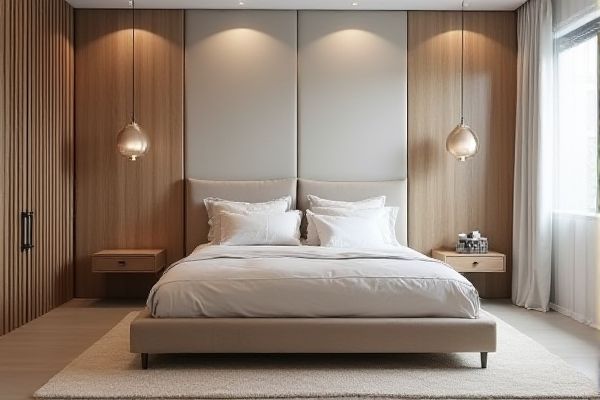
Platform beds offer a solid, flat surface that supports your mattress without the need for a box spring, providing a modern and minimalist look. Panel beds feature headboards, footboards, and side rails with framed panels, adding a traditional and decorative touch to your bedroom; explore this article to discover which bed style best fits your needs.
Table of Comparison
| Feature | Platform Bed | Panel Bed |
|---|---|---|
| Structure | Flat, solid surface for mattress support | Headboard, footboard, and side panels |
| Support | Built-in slats or solid base, no box spring needed | Usually requires box spring or foundation |
| Style | Modern, minimalist design | Traditional, ornate design |
| Storage | Often includes under-bed storage options | Limited or no under-bed storage |
| Assembly | Simple assembly with fewer parts | More complex assembly due to panels |
| Durability | Sturdy and stable platform | Varies based on panel materials and construction |
| Price Range | Generally affordable to mid-range | Mid-range to high-end pricing |
Platform Bed vs Panel Bed: Key Differences
Platform beds feature a solid or slatted base that supports a mattress without the need for a box spring, offering a modern and minimalist design ideal for memory foam or hybrid mattresses. Panel beds consist of a headboard, footboard, and side rails made from flat panels, providing a more traditional look with sturdy wooden construction often crafted from materials like oak, pine, or cherry. The primary difference lies in the support system and style, where platform beds emphasize functionality and simplicity, while panel beds focus on decorative elements and structural framing.
What is a Platform Bed?
A platform bed is a modern bed frame featuring a sturdy, flat base designed to support a mattress without the need for a box spring, often constructed from wood or metal. Its low-profile design provides enhanced stability and a minimalist aesthetic, making it popular in contemporary bedroom setups. The integrated slats or solid surface of platform beds offer excellent mattress ventilation and durability.
Understanding Panel Beds
Panel beds feature a headboard, footboard, and side rails constructed from flat wood panels, offering sturdy support and a classic aesthetic. Unlike platform beds, which rely on a solid or slatted base for mattress support, panel beds often require a box spring to enhance mattress longevity and comfort. Choosing a panel bed emphasizes traditional design elements and structural durability in bedroom furniture.
Pros and Cons of Platform Beds
Platform beds offer a sturdy, low-profile design that eliminates the need for a box spring, providing cost savings and ease of assembly. Their solid or slatted surfaces ensure better mattress support and airflow, promoting longevity and comfort, but the low height may be less convenient for people with mobility issues. On the downside, platform beds can be heavier and more challenging to move, and some models may lack the traditional aesthetic appeal found in panel beds.
Advantages and Disadvantages of Panel Beds
Panel beds offer a classic design with sturdy headboards and footboards crafted from solid wood or engineered materials, providing strong support and an elegant appearance. Their enclosed structure prevents mattress slipping and adds aesthetic appeal, but they are generally heavier and less flexible to move compared to platform beds, which lack bulky frames. Panel beds often require a box spring for mattress support, increasing overall cost and height, while platform beds typically use slats allowing direct mattress placement and greater price efficiency.
Mattress Support: Platform vs Panel Beds
Platform beds feature a solid or slatted base that provides direct support to the mattress, eliminating the need for a box spring and ensuring even weight distribution to enhance mattress durability. Panel beds use a traditional structure with headboards and footboards, often requiring a box spring for proper mattress support because the mattress sits on a frame rather than a solid surface. Mattress support in platform beds generally leads to better airflow and prevents sagging, whereas panel beds depend heavily on additional foundations for stability and comfort.
Design and Aesthetic Comparisons
Platform beds feature a minimalist design with a low-profile frame and a solid or slatted base, offering a modern and sleek aesthetic that complements contemporary interiors. Panel beds showcase a more traditional look with vertical or horizontal paneling on the headboard and footboard, often crafted from wood, providing a classic and elegant appeal to your bedroom. Choosing between the two depends on your preferred style: platform beds suit a clean, streamlined space, while panel beds add warmth and timeless charm.
Storage Options: Platform vs Panel Beds
Platform beds typically offer integrated storage solutions such as under-bed drawers or built-in compartments, maximizing space efficiency in your bedroom. Panel beds, characterized by their traditional headboards and footboards, often lack built-in storage, requiring separate furniture for organization. Choosing a platform bed can enhance your room's functionality by combining sleeping and storage needs seamlessly.
Price and Value Considerations
Platform beds typically offer more affordable options with built-in slats that eliminate the need for a box spring, providing better value for budget-conscious buyers. Panel beds, often featuring intricate designs and solid wood construction, tend to be pricier but add a timeless aesthetic that can increase your bedroom's overall appeal. When deciding, consider if your priority is upfront savings or long-term investment in styling and durability.
How to Choose: Platform Bed or Panel Bed?
Choosing between a platform bed and a panel bed depends on your bedroom style, storage needs, and mattress compatibility. Platform beds offer a sleek, minimalistic design with built-in slats that eliminate the need for a box spring, ideal for modern aesthetics and cost-efficiency. Panel beds feature a headboard and footboard, adding a classic, decorative element while accommodating traditional mattress setups and often providing additional storage options.
 homyna.com
homyna.com